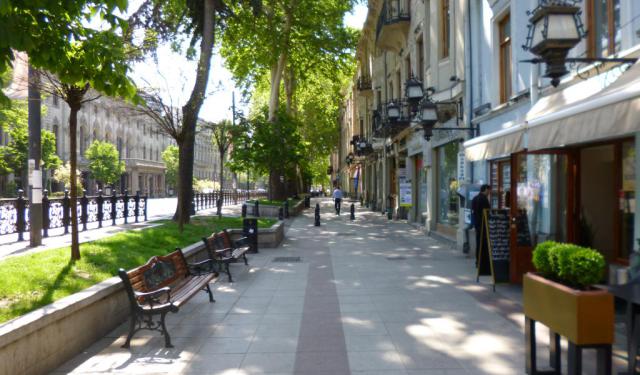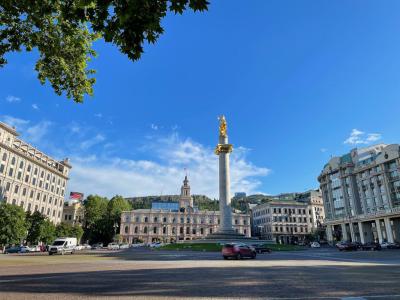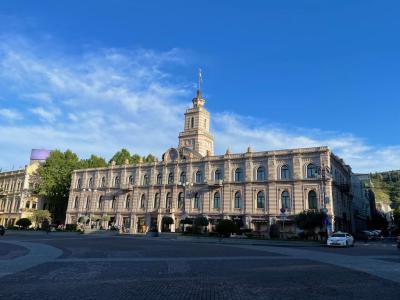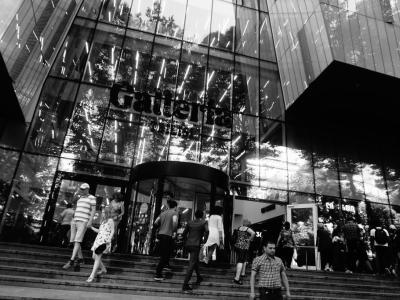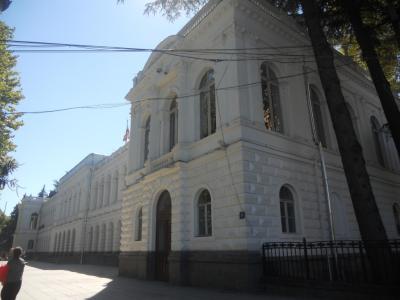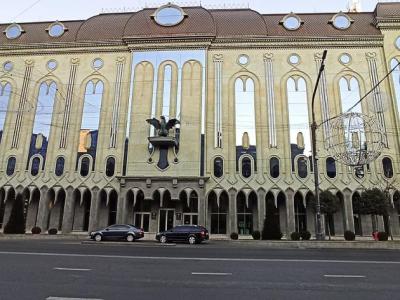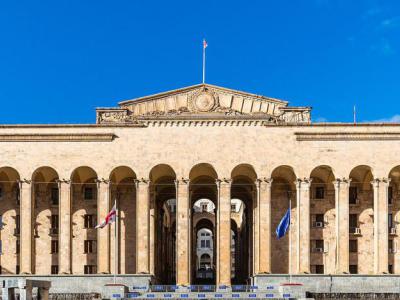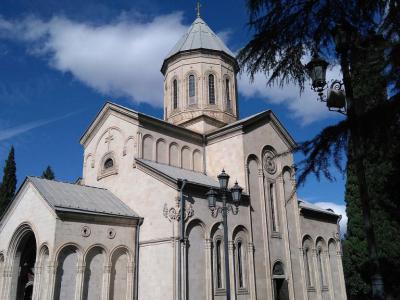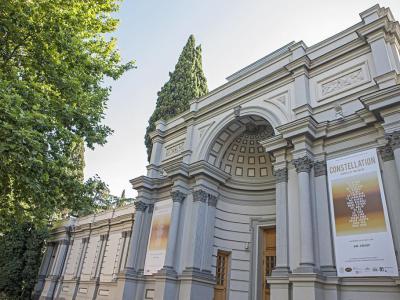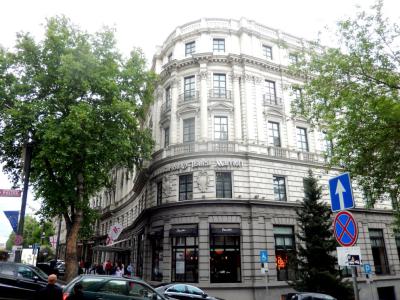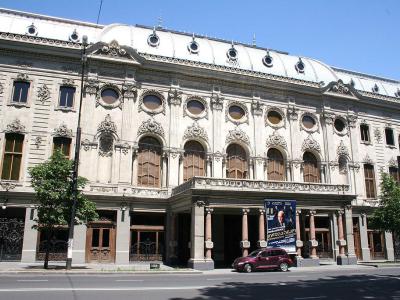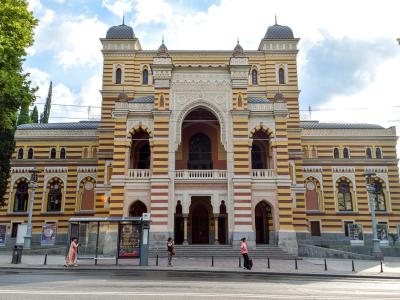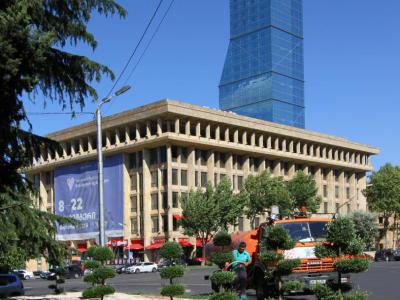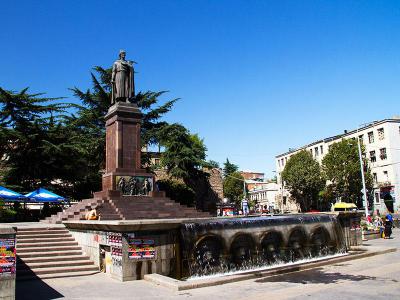Rustaveli Avenue Walking Tour (Self Guided), Tbilisi
If Tbilisi is the heart of Georgia, then Rustaveli Avenue is its pulse. As the capital's main artery, the importance – historical, cultural, or architectural – of this vibrant and bustling thoroughfare is hard to overestimate.
Named after the renowned medieval Georgian poet Shota Rustaveli, the avenue starts from Freedom Square – a key downtown landmark, home to the iconic statue of Saint George slaying the dragon – and stretches for about 1.5 kilometers down to the outskirts of the city center.
Cultural institutions, such as the Georgian National Opera & Ballet Theater and the Georgian Museum of Fine Arts, abound the street alongside other prominent landmarks such as the imposing Parliament building and the Tbilisi City Assembly, not to mention upscale hotels like the luxurious Tbilisi Marriott Hotel, and numerous shops and entertainment venues.
Rustaveli Avenue is also "the stage where Tbilisi performs" – this metaphor emphasizes the lively and dynamic nature of the place, always crowded with people going about their daily business or leisurely pleasures, political rallies, and other public events.
Some say that if you haven't walked down Rustaveli, you haven't truly experienced Tbilisi, suggesting that exploring it is an essential part of fully immersing yourself in the spirit and soul of the Georgian capital. To capture the essence of Rustaveli Avenue and its significance in the collective imagination of Tbilisi and Georgia, take this self-guided walk.
Named after the renowned medieval Georgian poet Shota Rustaveli, the avenue starts from Freedom Square – a key downtown landmark, home to the iconic statue of Saint George slaying the dragon – and stretches for about 1.5 kilometers down to the outskirts of the city center.
Cultural institutions, such as the Georgian National Opera & Ballet Theater and the Georgian Museum of Fine Arts, abound the street alongside other prominent landmarks such as the imposing Parliament building and the Tbilisi City Assembly, not to mention upscale hotels like the luxurious Tbilisi Marriott Hotel, and numerous shops and entertainment venues.
Rustaveli Avenue is also "the stage where Tbilisi performs" – this metaphor emphasizes the lively and dynamic nature of the place, always crowded with people going about their daily business or leisurely pleasures, political rallies, and other public events.
Some say that if you haven't walked down Rustaveli, you haven't truly experienced Tbilisi, suggesting that exploring it is an essential part of fully immersing yourself in the spirit and soul of the Georgian capital. To capture the essence of Rustaveli Avenue and its significance in the collective imagination of Tbilisi and Georgia, take this self-guided walk.
How it works: Download the app "GPSmyCity: Walks in 1K+ Cities" from Apple App Store or Google Play Store to your mobile phone or tablet. The app turns your mobile device into a personal tour guide and its built-in GPS navigation functions guide you from one tour stop to next. The app works offline, so no data plan is needed when traveling abroad.
Rustaveli Avenue Walking Tour Map
Guide Name: Rustaveli Avenue Walking Tour
Guide Location: Georgia » Tbilisi (See other walking tours in Tbilisi)
Guide Type: Self-guided Walking Tour (Sightseeing)
# of Attractions: 13
Tour Duration: 2 Hour(s)
Travel Distance: 2.5 Km or 1.6 Miles
Author: DanaOffice
Sight(s) Featured in This Guide:
Guide Location: Georgia » Tbilisi (See other walking tours in Tbilisi)
Guide Type: Self-guided Walking Tour (Sightseeing)
# of Attractions: 13
Tour Duration: 2 Hour(s)
Travel Distance: 2.5 Km or 1.6 Miles
Author: DanaOffice
Sight(s) Featured in This Guide:
- Freedom Square
- Tbilisi City Assembly
- Galleria Tbilisi Shopping Mall
- National Youth and Children's Palace
- Georgian Museum of Fine Arts
- Georgian Parliament Building
- Kashveti Church of St. George
- Tbilisi Art Gallery
- Tbilisi Marriott Hotel
- Rustaveli National Theatre
- Georgian National Opera Theater
- IMELI Building
- Shota Rustaveli Monument and Fountain
1) Freedom Square
Freedom Square is one of the most prominent landmarks in Tbilisi, Georgia, symbolizing the country’s independence and unity. Located at the eastern end of Rustaveli Avenue, it serves as a central hub connecting Tbilisi’s historic Old Town with its modern business and cultural districts. The square has witnessed many pivotal events in Georgian history, from 19th-century demonstrations to the 2003 Rose Revolution.
At the heart of Freedom Square stands the Statue of Saint George, a gleaming golden monument created by sculptor Zurab Tsereteli in 2006. Depicting Georgia’s patron saint slaying a dragon, the statue represents triumph and freedom. Surrounding the square are several notable buildings, including the Tbilisi City Hall, a striking neo-Moorish structure, and the Courtyard by Marriott Hotel, housed in a historic building with elegant architecture.
Nearby attractions include the entrance to Rustaveli Avenue, lined with theaters, museums, and cafés, and the charming Old Town, filled with winding streets, traditional balconies, and historic churches. Freedom Square is also a popular site for national celebrations, public gatherings, and concerts, making it not only a geographic center but also a symbol of Georgian identity and resilience.
At the heart of Freedom Square stands the Statue of Saint George, a gleaming golden monument created by sculptor Zurab Tsereteli in 2006. Depicting Georgia’s patron saint slaying a dragon, the statue represents triumph and freedom. Surrounding the square are several notable buildings, including the Tbilisi City Hall, a striking neo-Moorish structure, and the Courtyard by Marriott Hotel, housed in a historic building with elegant architecture.
Nearby attractions include the entrance to Rustaveli Avenue, lined with theaters, museums, and cafés, and the charming Old Town, filled with winding streets, traditional balconies, and historic churches. Freedom Square is also a popular site for national celebrations, public gatherings, and concerts, making it not only a geographic center but also a symbol of Georgian identity and resilience.
2) Tbilisi City Assembly
The Tbilisi City Assembly, also known as the Tbilisi Sakrebulo or Tbilisi City Council, is the representative body of the city government in Tbilisi. It was established as part of the reforms instituted in 1991 when Georgia declared its independence from the Soviet Union. The Sakrebulos, including the one in Tbilisi, were created as the legislative branches of local government throughout the country.
The current location of the Tbilisi City Assembly is the result of a comprehensive and gradual reconstruction project that transformed a 19th-century city police building. Originally constructed during the Russian Empire in the 1830s, the building underwent multiple renovations over the last two centuries, giving it a distinct appearance. Initially, it served as the Chancellery of Chief Policemaster and later as a police department until 1879.
In 1878, a competition was held to remodel the building into the City Hall, and the winning design was created by architect Paul Stern. The exterior architecture of the building reflects the prevailing exotic style of that era, with a neo-Moorish design. A tower was added to the structure in 1910, and further expansions took place in 1912.
Today, the Tbilisi City Assembly stands as an important symbol of the city's history and governance. It serves as the meeting place for the city councilors who represent the interests of Tbilisi's residents and make decisions on matters concerning the city's administration, policies, and services.
The current location of the Tbilisi City Assembly is the result of a comprehensive and gradual reconstruction project that transformed a 19th-century city police building. Originally constructed during the Russian Empire in the 1830s, the building underwent multiple renovations over the last two centuries, giving it a distinct appearance. Initially, it served as the Chancellery of Chief Policemaster and later as a police department until 1879.
In 1878, a competition was held to remodel the building into the City Hall, and the winning design was created by architect Paul Stern. The exterior architecture of the building reflects the prevailing exotic style of that era, with a neo-Moorish design. A tower was added to the structure in 1910, and further expansions took place in 1912.
Today, the Tbilisi City Assembly stands as an important symbol of the city's history and governance. It serves as the meeting place for the city councilors who represent the interests of Tbilisi's residents and make decisions on matters concerning the city's administration, policies, and services.
3) Galleria Tbilisi Shopping Mall
Galleria Tbilisi, located at Liberty Square is a multifunctional shopping center that has breathed new life into the heart of the city. This dynamic establishment serves as a destination for all everyday needs, offering a wide range of services and amenities to visitors.
As one of the popular shopping centers in Tbilisi, Galleria Tbilisi boasts a plethora of well-known brand stores, making it a haven for fashion enthusiasts. From clothing and accessories to sports equipment and household appliances, shoppers can find a diverse selection of products to cater to their preferences. The center also houses the Liberty Theater, the Griboedov Theater, the Cavea Cinema, and the Bowling Hall, providing a variety of entertainment options for visitors to enjoy. Additionally, the center features a dedicated kids' entertainment center called "Ria Ria," ensuring that families have an enjoyable experience.
The layout of Galleria Tbilisi is thoughtfully designed to cater to visitors of all ages and interests. The commercial zones, supermarket "Goodwill," entertainment establishments, cafes, and various service providers come together to create a vibrant and diverse environment. Whether you're seeking a shopping spree, a place to dine, or a range of services, Galleria Tbilisi aims to fulfill your needs.
The mall is spread across eight floors, offering ample space for visitors to explore and discover a wide array of offerings. From fashion boutiques to specialty stores, the center strives to provide a comprehensive and enjoyable shopping experience.
When it comes to dining options, Galleria Tbilisi has you covered. With a variety of cafes, restaurants, and fast food corners, visitors can satisfy their culinary cravings and indulge in delicious food. Whether you're in the mood for local Georgian cuisine or international flavors, there are options to suit every taste.
As one of the popular shopping centers in Tbilisi, Galleria Tbilisi boasts a plethora of well-known brand stores, making it a haven for fashion enthusiasts. From clothing and accessories to sports equipment and household appliances, shoppers can find a diverse selection of products to cater to their preferences. The center also houses the Liberty Theater, the Griboedov Theater, the Cavea Cinema, and the Bowling Hall, providing a variety of entertainment options for visitors to enjoy. Additionally, the center features a dedicated kids' entertainment center called "Ria Ria," ensuring that families have an enjoyable experience.
The layout of Galleria Tbilisi is thoughtfully designed to cater to visitors of all ages and interests. The commercial zones, supermarket "Goodwill," entertainment establishments, cafes, and various service providers come together to create a vibrant and diverse environment. Whether you're seeking a shopping spree, a place to dine, or a range of services, Galleria Tbilisi aims to fulfill your needs.
The mall is spread across eight floors, offering ample space for visitors to explore and discover a wide array of offerings. From fashion boutiques to specialty stores, the center strives to provide a comprehensive and enjoyable shopping experience.
When it comes to dining options, Galleria Tbilisi has you covered. With a variety of cafes, restaurants, and fast food corners, visitors can satisfy their culinary cravings and indulge in delicious food. Whether you're in the mood for local Georgian cuisine or international flavors, there are options to suit every taste.
4) National Youth and Children's Palace
The National Youth and Children's Palace, also known as Pioneer Palace, National Palace, or its original name - Viceroy's Palace, is a historic edifice situated on Rustaveli Avenue in Tbilisi.
The building's origins date back to 1802 when the Russian government established its presence in Georgia. A new palace was built in 1807, showcasing Russian classicism and becoming the most magnificent building in Tbilisi at the time. The palace underwent multiple reconstructions, with architect Brownmiller transforming it into the true residence of the Commander-in-Chief in 1818. Between 1845 and 1847, architect Semyonov extensively renovated the palace, giving it a distinctive neoclassical appearance. The palace garden and a fountain were added during this period.
In 1865, Otto Jakob Simonson, a Swedish architect working in Tbilisi, embarked on a comprehensive reconstruction project that spanned four years. By 1869, the Viceroy's Palace assumed its final form, which is the structure we see today. Simonson substantially expanded upon Semyonov's design, breathing new life into the palace.
In 1917, the palace became the headquarters of the Transcaucasian Democratic Federative Republic. On May 26, 1918, the federation dissolved in the palace. Later that day, Georgia's National Council met there and declared independence. Two days later, Azerbaijan also declared independence in the same palace. The Government of Georgia then occupied the palace, serving as the initial seat for the National Council and the Constituent Assembly. On February 21, 1921, the Democratic Republic's Constitution was adopted in these chambers. In 1937, the palace was entrusted to children, and on April 2, 1941, it opened its doors to them.
The building's origins date back to 1802 when the Russian government established its presence in Georgia. A new palace was built in 1807, showcasing Russian classicism and becoming the most magnificent building in Tbilisi at the time. The palace underwent multiple reconstructions, with architect Brownmiller transforming it into the true residence of the Commander-in-Chief in 1818. Between 1845 and 1847, architect Semyonov extensively renovated the palace, giving it a distinctive neoclassical appearance. The palace garden and a fountain were added during this period.
In 1865, Otto Jakob Simonson, a Swedish architect working in Tbilisi, embarked on a comprehensive reconstruction project that spanned four years. By 1869, the Viceroy's Palace assumed its final form, which is the structure we see today. Simonson substantially expanded upon Semyonov's design, breathing new life into the palace.
In 1917, the palace became the headquarters of the Transcaucasian Democratic Federative Republic. On May 26, 1918, the federation dissolved in the palace. Later that day, Georgia's National Council met there and declared independence. Two days later, Azerbaijan also declared independence in the same palace. The Government of Georgia then occupied the palace, serving as the initial seat for the National Council and the Constituent Assembly. On February 21, 1921, the Democratic Republic's Constitution was adopted in these chambers. In 1937, the palace was entrusted to children, and on April 2, 1941, it opened its doors to them.
5) Georgian Museum of Fine Arts
The Georgian Museum of Fine Arts is located on Rustaveli Avenue in Tbilisi. It is a private art museum built in 2013, solely dedicated to hosting art exhibitions. It officially opened on September 26, 2018. The museum houses over 3500 artworks created by 80 artists in the past 70 years. These valuable pieces comprise the private art collection of the Jokhtaberidze-Shevardnadze family, the founders of Magticom, the largest telecommunications company in Georgia.
Dr. George Jokhtaberidze and Manana Shevardnadze started collecting art in the 1990s. Dr. Jokhtaberidze, successful in his entrepreneurial pursuits, began acquiring art out of personal interest. During a shopping trip, he found a gallery selling art at very low prices, which made him realize the need to curate, document, and exhibit art properly instead of scattering it worldwide. Since much of the art was from the Soviet Union era behind the Iron Curtain, its recognition was limited. Thus, the mission was born: to gather, restore, and protect Georgian art. Initially, the plan was to donate the collection to state museums, but the collapse of the USSR and subsequent upheavals left the state museums unable to accommodate the entire collection.
Over 23 years, as art continued to be amassed and while simultaneously leading Georgia's largest telecommunications company, Dr. George Jokhtaberidze seized an opportunity to acquire real estate directly in front of the Georgian Parliament building. Swiftly transforming this opportunity into a comprehensive plan, he set in motion the development of a complex that would encompass the Georgian Museum of Fine Arts and the Art House.
Dr. George Jokhtaberidze and Manana Shevardnadze started collecting art in the 1990s. Dr. Jokhtaberidze, successful in his entrepreneurial pursuits, began acquiring art out of personal interest. During a shopping trip, he found a gallery selling art at very low prices, which made him realize the need to curate, document, and exhibit art properly instead of scattering it worldwide. Since much of the art was from the Soviet Union era behind the Iron Curtain, its recognition was limited. Thus, the mission was born: to gather, restore, and protect Georgian art. Initially, the plan was to donate the collection to state museums, but the collapse of the USSR and subsequent upheavals left the state museums unable to accommodate the entire collection.
Over 23 years, as art continued to be amassed and while simultaneously leading Georgia's largest telecommunications company, Dr. George Jokhtaberidze seized an opportunity to acquire real estate directly in front of the Georgian Parliament building. Swiftly transforming this opportunity into a comprehensive plan, he set in motion the development of a complex that would encompass the Georgian Museum of Fine Arts and the Art House.
6) Georgian Parliament Building
The Parliament of Georgia Building is where the members of the Parliament of Georgia gather in Tbilisi. It is situated on Rustaveli Avenue, close to the base of Mount Mtatsminda.
The building complex was originally constructed as the House of Government of Georgian SSR on the site of the Alexander Nevsky Cathedral. The cathedral, adjacent churchyard, and the graves of Georgian cadets who died in the Bolshevik invasion in 1921 were demolished. The Parliament Building consists of two structures. The "upper" building was designed by Viktor Kokorin and Giorgi Lezhava and built between 1933 and 1938. The "lower" building, facing Rustaveli Avenue, was constructed by the same architects with input from Vladimer Nasaridze between 1946 and 1953.
The buildings are connected by a courtyard with staircases and fountains. They incorporate elements of traditional Georgian architecture, with a notable grand arcade, imposing eaves, and an arched pediment facing the avenue. The buildings are made of lightweight reinforced concrete, with tufa rock, granite, and other materials used for the exterior cladding.
The complex was damaged during the 1991-1992 military coup. President Gamsakhurdia took shelter in an underground bunker. Later, the building was restored and became the Parliament seat from 1997 to 2012. A new Parliament building was then constructed in Kutaisi. In 2014, committee meetings were held in Tbilisi, while sessions took place in Kutaisi. However, a 2017 amendment removed Kutaisi as the Parliament seat. Thus, the Parliament fully returned to the capital in January 2019.
The building complex was originally constructed as the House of Government of Georgian SSR on the site of the Alexander Nevsky Cathedral. The cathedral, adjacent churchyard, and the graves of Georgian cadets who died in the Bolshevik invasion in 1921 were demolished. The Parliament Building consists of two structures. The "upper" building was designed by Viktor Kokorin and Giorgi Lezhava and built between 1933 and 1938. The "lower" building, facing Rustaveli Avenue, was constructed by the same architects with input from Vladimer Nasaridze between 1946 and 1953.
The buildings are connected by a courtyard with staircases and fountains. They incorporate elements of traditional Georgian architecture, with a notable grand arcade, imposing eaves, and an arched pediment facing the avenue. The buildings are made of lightweight reinforced concrete, with tufa rock, granite, and other materials used for the exterior cladding.
The complex was damaged during the 1991-1992 military coup. President Gamsakhurdia took shelter in an underground bunker. Later, the building was restored and became the Parliament seat from 1997 to 2012. A new Parliament building was then constructed in Kutaisi. In 2014, committee meetings were held in Tbilisi, while sessions took place in Kutaisi. However, a 2017 amendment removed Kutaisi as the Parliament seat. Thus, the Parliament fully returned to the capital in January 2019.
7) Kashveti Church of St. George
The Kashveti Church of Saint George is a prominent Georgian Orthodox Church located in central Tbilisi. Situated across from the Parliament Building on Rustaveli Avenue, it holds a significant place in the city's architectural and cultural landscape.
Constructed between 1904 and 1910, the church was designed by the renowned architect Leopold Bilfeldt. Bilfeldt drew inspiration from the medieval Samtavisi Cathedral when creating the architectural plans for Kashveti. The construction of the church was made possible through the generous sponsorship of the Georgian nobility and bourgeoisie.
The current Kashveti Church stands on the site of a previously damaged church, which had been built in 1753 at the request of the Amilakhvari family. The new structure incorporated elements of the original design while adding modern features. Notably, N. Agladze contributed significantly to the ornate design of the church.
One of the notable artistic features of Kashveti Church is its beautiful frescoes, which were painted by Lado Gudiashvili, an influential Georgian painter, in 1947. Gudiashvili's frescoes enhance the interior of the church, adding a sense of grandeur and beauty to the worship space.
Constructed between 1904 and 1910, the church was designed by the renowned architect Leopold Bilfeldt. Bilfeldt drew inspiration from the medieval Samtavisi Cathedral when creating the architectural plans for Kashveti. The construction of the church was made possible through the generous sponsorship of the Georgian nobility and bourgeoisie.
The current Kashveti Church stands on the site of a previously damaged church, which had been built in 1753 at the request of the Amilakhvari family. The new structure incorporated elements of the original design while adding modern features. Notably, N. Agladze contributed significantly to the ornate design of the church.
One of the notable artistic features of Kashveti Church is its beautiful frescoes, which were painted by Lado Gudiashvili, an influential Georgian painter, in 1947. Gudiashvili's frescoes enhance the interior of the church, adding a sense of grandeur and beauty to the worship space.
8) Tbilisi Art Gallery
The Tbilisi Art Gallery, also known as the National Gallery, is an art gallery situated on Rustaveli Avenue in Tbilisi. It has a historical significance to the locals, who used to call it the Blue Gallery due to its blue-green painted facade, although it has now been painted gray.
The origins of the National Art Gallery can be traced back to the late 19th century. It was established thanks to the efforts of Dimitri Shevardnadze, a renowned Georgian artist, and public figure. The building itself was constructed in 1888 under the decision of the Russian emperor and housed the Russian Military Historical Museum as well as a hall of fame.
The Art Gallery held its first exhibition in October 1920. Initially, its exhibition policy focused on showcasing the works of Georgian and foreign artists, spanning various art periods and styles that were considered valuable or relevant to Georgia.
The gallery building was originally intended to house the mibadzvitaa (a type of exhibition space). Its facade facing Rustaveli Avenue is intricately decorated in the Baroque style, with the entrance located at the center. The two rooms within the gallery feature glass ceilings, allowing natural sunlight to illuminate the space.
In 2007, the Tbilisi Art Gallery became part of the National Museum of Georgia. Extensive reconstruction of the gallery building was undertaken, resulting in improvements to the central facade and exhibition area. The expansion also involved the creation of additional gallery space through landscaping. The renovated gallery now consists of eight rooms, a restoration laboratory, storage facilities for temporary exhibitions, a training area, and a public shop.
On November 7, 2006, the Tbilisi Art Gallery was officially designated as a Monument of National Importance in Georgia, according to a decree issued by the President of Georgia.
The origins of the National Art Gallery can be traced back to the late 19th century. It was established thanks to the efforts of Dimitri Shevardnadze, a renowned Georgian artist, and public figure. The building itself was constructed in 1888 under the decision of the Russian emperor and housed the Russian Military Historical Museum as well as a hall of fame.
The Art Gallery held its first exhibition in October 1920. Initially, its exhibition policy focused on showcasing the works of Georgian and foreign artists, spanning various art periods and styles that were considered valuable or relevant to Georgia.
The gallery building was originally intended to house the mibadzvitaa (a type of exhibition space). Its facade facing Rustaveli Avenue is intricately decorated in the Baroque style, with the entrance located at the center. The two rooms within the gallery feature glass ceilings, allowing natural sunlight to illuminate the space.
In 2007, the Tbilisi Art Gallery became part of the National Museum of Georgia. Extensive reconstruction of the gallery building was undertaken, resulting in improvements to the central facade and exhibition area. The expansion also involved the creation of additional gallery space through landscaping. The renovated gallery now consists of eight rooms, a restoration laboratory, storage facilities for temporary exhibitions, a training area, and a public shop.
On November 7, 2006, the Tbilisi Art Gallery was officially designated as a Monument of National Importance in Georgia, according to a decree issued by the President of Georgia.
9) Tbilisi Marriott Hotel
The Tbilisi Marriott Hotel is a luxurious five-star hotel situated in Tbilisi. It is located on the city's main boulevard, Rustaveli Avenue, and was originally constructed between 1911 and 1915 as a high-end establishment commissioned by a wealthy Armenian merchant named Mikael Aramyants.
Designed by Aleksandr Ozerov in 1911, the hotel aimed to be the finest in Tbilisi, which was then the capital of Russian-ruled Georgia and the wider Caucasus region. Later, Gabriel Ter-Mikelov made some modifications to the hotel at the request of Mikael Aramyants. The construction of the hotel was eventually completed in 1915, and it was named Hôtel Majestic. However, during World War I, from 1915 to 1917, the hotel temporarily served as a military hospital before it could be opened to the public.
Unfortunately, the hotel suffered significant damage from a fire during the December 1991–January 1992 coup d'état, which marked the beginning of the Georgian Civil War. Following this event, the hotel underwent reconstruction under the guidance of architects G. Metreveli and V. Kurtishvili between 1995 and 2002. The refurbished Tbilisi Marriott Hotel officially opened its doors on September 26, 2002.
The hotel is a seven-story building, with five stories above ground. Its grand facades still showcase their original design, incorporating elements of Renaissance and Baroque architecture. These features include justification, prominent semi-circular and flat pilasters adorned with Corinthian capitals, and triangular and circular pediments supported by stone brackets. The front entrance facing Rustaveli Avenue is enhanced by large columns, while the main facade boasts an elaborate entablature and attic, complete with a molded balustrade parapet.
Designed by Aleksandr Ozerov in 1911, the hotel aimed to be the finest in Tbilisi, which was then the capital of Russian-ruled Georgia and the wider Caucasus region. Later, Gabriel Ter-Mikelov made some modifications to the hotel at the request of Mikael Aramyants. The construction of the hotel was eventually completed in 1915, and it was named Hôtel Majestic. However, during World War I, from 1915 to 1917, the hotel temporarily served as a military hospital before it could be opened to the public.
Unfortunately, the hotel suffered significant damage from a fire during the December 1991–January 1992 coup d'état, which marked the beginning of the Georgian Civil War. Following this event, the hotel underwent reconstruction under the guidance of architects G. Metreveli and V. Kurtishvili between 1995 and 2002. The refurbished Tbilisi Marriott Hotel officially opened its doors on September 26, 2002.
The hotel is a seven-story building, with five stories above ground. Its grand facades still showcase their original design, incorporating elements of Renaissance and Baroque architecture. These features include justification, prominent semi-circular and flat pilasters adorned with Corinthian capitals, and triangular and circular pediments supported by stone brackets. The front entrance facing Rustaveli Avenue is enhanced by large columns, while the main facade boasts an elaborate entablature and attic, complete with a molded balustrade parapet.
10) Rustaveli National Theatre
The Rustaveli National Theatre, situated on Rustaveli Avenue in Tbilisi, is the country's largest and one of its oldest theaters. It was established in 1887 and has been named after Georgia's national poet, Rustaveli, since 1921. The theater occupies an elaborate Rococo-style building.
Originally known as the "Artists' Society," the theater's construction began in 1887. Renowned artists, including Lado Gudiashvili, David Kakabadze, and Serge Sudeikin, were commissioned to create frescoes in the basement. Mose and Iracly Toidze later joined the project. Sadly, the Soviet era led to the whitewashing of the magnificent frescoes in the lower level of Rustaveli Theatre, with only a small portion restored.
In 1921, the theater was renamed Rustaveli Theatre and was constructed with the financial support of Alexander Mantashev. The design of the building was created by Cornell K. Tatishchev and Aleksander Szymkiewicz, who was the Municipal Architect of Tbilisi at the time. From 2002 to 2005, the theater underwent an extensive renovation.
The theater consists of three stages: the main stage with approximately 800 seats, the small stage with 283 seats, and a Black Box Theatre with 182 seats, which is used for experimental performances. Additionally, the theater provides spaces for conferences and events, including a large ballroom, a small ballroom, and a small foyer.
Originally known as the "Artists' Society," the theater's construction began in 1887. Renowned artists, including Lado Gudiashvili, David Kakabadze, and Serge Sudeikin, were commissioned to create frescoes in the basement. Mose and Iracly Toidze later joined the project. Sadly, the Soviet era led to the whitewashing of the magnificent frescoes in the lower level of Rustaveli Theatre, with only a small portion restored.
In 1921, the theater was renamed Rustaveli Theatre and was constructed with the financial support of Alexander Mantashev. The design of the building was created by Cornell K. Tatishchev and Aleksander Szymkiewicz, who was the Municipal Architect of Tbilisi at the time. From 2002 to 2005, the theater underwent an extensive renovation.
The theater consists of three stages: the main stage with approximately 800 seats, the small stage with 283 seats, and a Black Box Theatre with 182 seats, which is used for experimental performances. Additionally, the theater provides spaces for conferences and events, including a large ballroom, a small ballroom, and a small foyer.
11) Georgian National Opera Theater
The Georgian National Opera and Ballet Theater of Tbilisi, formerly known as the Tiflis Imperial Theater, is a renowned opera house located on Rustaveli Avenue. Established in 1851, the Tbilisi Opera is not only the main opera house of Georgia but also one of the oldest opera establishments in Eastern Europe.
The theater has been housed in a remarkable Moorish Revival building since 1896. This architectural gem was originally designed by Victor Johann Gottlieb Schröter, a prominent architect of Baltic German origin. Despite its definitively Oriental appearance, the layout, foyers, and main hall of the building adhere to the typical European opera house design.
The Georgian National Opera and Ballet Theater is not only a symbol of architectural splendor but also a vital center of cultural life in Tbilisi. The institution bears the name of Zacharia Paliashvili, the Georgian national composer, since 1937. Paliashvili's legacy and contributions to Georgian music are honored within the walls of this opera house. Furthermore, the theater is home to the State Ballet of Georgia, led by the internationally acclaimed Georgian ballerina, Nina Ananiashvili.
Over the years, the opera house has welcomed esteemed opera stars from around the world. Renowned performers such as Montserrat Caballé and José Carreras have graced its stage, captivating audiences with their exceptional talent. Additionally, the Georgian National Opera and Ballet Theater frequently serve as a venue for national celebrations and high-profile receptions, solidifying its position as a cultural and social hub in Tbilisi.
The theater has been housed in a remarkable Moorish Revival building since 1896. This architectural gem was originally designed by Victor Johann Gottlieb Schröter, a prominent architect of Baltic German origin. Despite its definitively Oriental appearance, the layout, foyers, and main hall of the building adhere to the typical European opera house design.
The Georgian National Opera and Ballet Theater is not only a symbol of architectural splendor but also a vital center of cultural life in Tbilisi. The institution bears the name of Zacharia Paliashvili, the Georgian national composer, since 1937. Paliashvili's legacy and contributions to Georgian music are honored within the walls of this opera house. Furthermore, the theater is home to the State Ballet of Georgia, led by the internationally acclaimed Georgian ballerina, Nina Ananiashvili.
Over the years, the opera house has welcomed esteemed opera stars from around the world. Renowned performers such as Montserrat Caballé and José Carreras have graced its stage, captivating audiences with their exceptional talent. Additionally, the Georgian National Opera and Ballet Theater frequently serve as a venue for national celebrations and high-profile receptions, solidifying its position as a cultural and social hub in Tbilisi.
12) IMELI Building
The Biltmore Hotel Tbilisi is a prestigious hotel managed by Millennium & Copthorne Hotels. It is situated on Rustaveli Avenue, the main street in the city, and comprises two main structures. The first is the historic IMELI building, which was built during the Soviet era in the 1930s and showcases Stalin-era Socialist Classicism. Designed by Alexey Shchusev, the IMELI building originally housed the Tbilisi branch of the Marx-Engels-Lenin Institute. It is known for its eclectic design, blending elements of Socialist Classicism and Constructivism.
The building features intricate woodwork, metalwork, and Georgian marble, both on the exterior and interior. Noteworthy Georgian sculptors, Iakob Nikoladze and Tamar Abakelia contributed to its facades. In 1986, the IMELI building was recognized as an architectural heritage site. Following the collapse of the Soviet Union in 1991, the IMELI building transitioned to government use, and certain Communist-era symbols and decorations were removed from its facades.
In 2011, Tbilisi City Hall granted permission for a new investor to construct a 32-story glass skyscraper adjacent to the Shchusev-designed building. This modern addition, towering at a height of 138 meters, creates a striking contrast with the predominantly 19th and early 20th-century architecture found along Rustaveli Avenue. A glass walkway now connects the IMELI building to the newly constructed skyscraper.
The building features intricate woodwork, metalwork, and Georgian marble, both on the exterior and interior. Noteworthy Georgian sculptors, Iakob Nikoladze and Tamar Abakelia contributed to its facades. In 1986, the IMELI building was recognized as an architectural heritage site. Following the collapse of the Soviet Union in 1991, the IMELI building transitioned to government use, and certain Communist-era symbols and decorations were removed from its facades.
In 2011, Tbilisi City Hall granted permission for a new investor to construct a 32-story glass skyscraper adjacent to the Shchusev-designed building. This modern addition, towering at a height of 138 meters, creates a striking contrast with the predominantly 19th and early 20th-century architecture found along Rustaveli Avenue. A glass walkway now connects the IMELI building to the newly constructed skyscraper.
13) Shota Rustaveli Monument and Fountain
The Shota Rustaveli Monument and Fountain in Tbilisi pays homage to the legendary medieval Georgian poet, Shota Rustaveli (1160 – 1220). Rustaveli is revered as the pre-eminent poet of the Georgian Golden Age and is considered one of the greatest contributors to Georgian literature. His most notable work, 'The Knight in the Panther's Skin,' stands as a Georgian national epic poem.
'The Knight in the Panther's Skin' has garnered international acclaim and has been translated into numerous languages. It was first published in 1712 in Tbilisi, the capital of Georgia. Unfortunately, little is known about Rustaveli from contemporary sources, but it is believed that he was born between 1160 and 1165. In 1191, he began serving Queen Tamar as the Minister of Finance, showcasing his multifaceted talents beyond poetry.
The Rustaveli Monument was erected in 1942 on a square that bears his name. The monument stands as a testament to Rustaveli's cultural significance and enduring legacy in Georgian literature. Behind the monument, one can find the Rustaveli subway station, serving as a transportation hub in the city.
The sculpture of Shota Rustaveli is surrounded by small gardens, adding a touch of greenery and serenity to the square. In front of the monument, a fountain adorned with a bas-relief featuring the heads of lions stands as a captivating centerpiece. The fountain's design and artistic elements further enhance the overall aesthetic appeal of the square, providing visitors with a visually pleasing experience.
The Shota Rustaveli Monument and Fountain serve as a gathering place for locals and tourists alike, offering a tranquil spot to appreciate the cultural heritage of Georgia and pay tribute to the influential poet. The monument and its surroundings invite contemplation, reflection, and appreciation of Rustaveli's significant contributions to Georgian literature and the country's rich history.
'The Knight in the Panther's Skin' has garnered international acclaim and has been translated into numerous languages. It was first published in 1712 in Tbilisi, the capital of Georgia. Unfortunately, little is known about Rustaveli from contemporary sources, but it is believed that he was born between 1160 and 1165. In 1191, he began serving Queen Tamar as the Minister of Finance, showcasing his multifaceted talents beyond poetry.
The Rustaveli Monument was erected in 1942 on a square that bears his name. The monument stands as a testament to Rustaveli's cultural significance and enduring legacy in Georgian literature. Behind the monument, one can find the Rustaveli subway station, serving as a transportation hub in the city.
The sculpture of Shota Rustaveli is surrounded by small gardens, adding a touch of greenery and serenity to the square. In front of the monument, a fountain adorned with a bas-relief featuring the heads of lions stands as a captivating centerpiece. The fountain's design and artistic elements further enhance the overall aesthetic appeal of the square, providing visitors with a visually pleasing experience.
The Shota Rustaveli Monument and Fountain serve as a gathering place for locals and tourists alike, offering a tranquil spot to appreciate the cultural heritage of Georgia and pay tribute to the influential poet. The monument and its surroundings invite contemplation, reflection, and appreciation of Rustaveli's significant contributions to Georgian literature and the country's rich history.
Walking Tours in Tbilisi, Georgia
Create Your Own Walk in Tbilisi
Creating your own self-guided walk in Tbilisi is easy and fun. Choose the city attractions that you want to see and a walk route map will be created just for you. You can even set your hotel as the start point of the walk.
Tbilisi Introduction Walking Tour
American writer John Steinbeck was highly inspired by a full moon, as he loved the mystery it brought to any streetscape. After visiting Tbilisi, he did not hold back, calling the city „ghost-ridden”. He loved its cryptic atmosphere, shaped by centuries of change.
Tbilisi, the capital of Georgia, sits gracefully on both banks of the Kura River, framed by the rolling foothills of the... view more
Tour Duration: 1 Hour(s)
Travel Distance: 2.3 Km or 1.4 Miles
Tbilisi, the capital of Georgia, sits gracefully on both banks of the Kura River, framed by the rolling foothills of the... view more
Tour Duration: 1 Hour(s)
Travel Distance: 2.3 Km or 1.4 Miles
The Most Popular Cities
/ view all
